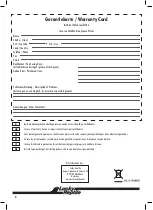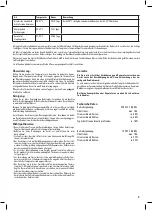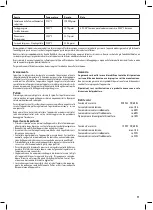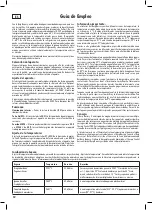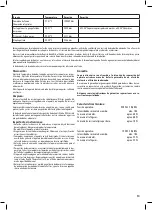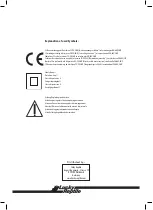
7
Hibernating:
Set the device to the desired temperature. Consider the chapter “Temperature
Setting” when doing so. Attention: this way of hibernating animals is only sui-
table for species that have a real hibernating period (not a resting period) in
nature during wintertime and are completely inactive at certain temperatures.
Please consult publications to inform yourself about the proper method before
deciding to hibernate an animal.
Open the device every two days for a short time to provide fresh air.
Cleaning:
Pull the plug before cleaning. Use a wet cloth to clean the device from the out-
side and inside and rub it dry after cleaning. Do never rinse or spray water on
the device.
Clean the vents regularly, e.g. with a brush to remove dust and other residues
that can decrease the performance of the device.
It is recommended to disinfect the device after use. Only use disinfectants that
are not based on alcohol, acids or other aggressive materials that can damage
the device.
Important Issue:
• Before placing eggs or animals into the device make a test run for a couple of
days to ensure the temperature is correct
• Do not make any changes to the device and do not open the case
• Make sure that the fans can rotate freely and no ventilation areas
are covered
• The device and cables have to be regularly checked for damages. In case of
discovering a problem, put the device immediately out of operation.
• Generally it should be verified if the device is applicable for the application
at hand before putting it into operation!
• To prevent the loss of eggs or animals regular temperature checks are re-
quired. No claims for loss of eggs are accepted in case of malfunction of the
device or wrong temperature.
• As typical for this price class, the device does not have a double thermostat
protection. We recommend to use another thermostat like the Lucky Reptile
Thermo Control II to add another safety mechanism.
• Under special conditions it is possible that condensed water is formed on the
back of the device.
Warranty
The warranty expires in case of modification and repair attempts as
well as damaging by force or inappropriate usage.
Neither a guarantee nor any liabilities for detriments or consequential da-
mages in relation with this product will be assumed. Repair, amendments or
exchange for a replacement are at the manufacturer’s discretion.
In case of warranty claims or repairs contact your specialist dealer.
Technical Data:
Operating voltage:
230V AC 50/60 Hz
Rated Current:
max 10 A
Power Consumption Heating:
approx.60W
Power Consumption Cooling:
approx. 60W
Typical Power Consumption per Hour:
approx. 10W
Operating voltage:
12V DC 50/60 Hz
Rated Current:
max 10 A
Power Consumption Heating:
approx.55W
Power Consumption Cooling:
approx. 55W
Species
Temperature
Duration
Notes
Hermann Tortoise
Testudo hermanni
28-31°C
54-79 days
At 25-30°C mostly males will hatch, at 33-34°C females
Ball Python
Python regius
29-32°C
55-71 days
Corn Snake
Elaphe guttata
25-29°C
55-86 days
We recommend incubating the eggs in a closed container with only a few ventilation holes and using a suitable substrate. This makes it easier to guarantee the
right humidity for the eggs and the substrate acts as temperature buffer reducing temperature fluctuations.
As substrate we recommend Lucky Reptile HatchRite which is being used by a lot of successful breeders. This breeding substrate already has the right humidity
and conserves water, so that it is not necessary to add water during the breeding process if used correctly.
Place the container with the eggs inside the device. In addition water can be added into the insert on the bottom to increase humidity.
Open the device two times a week to provide fresh air.


